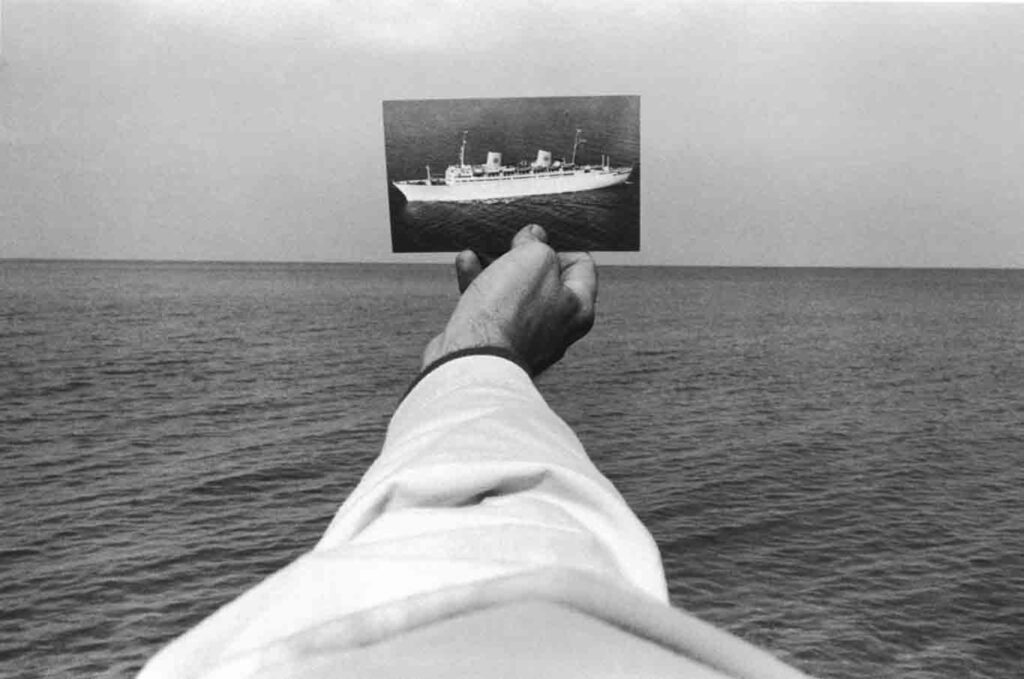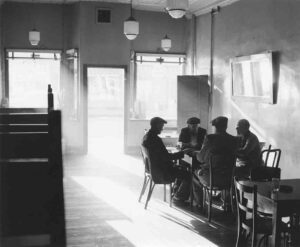
Kenneth Josephson: An Exhibition and Book Review

Gelatin silver photograph. c. 1967 print. Signed, titled, dated and annotated ’67-35-10-41′ in pencil by artist on print verso.
In an earlier lifetime, I collected postcards, mostly reproductions of pictures I liked: favorite artworks or photographs by favorite photographers. Sometimes, they were simply images that drew me. One such image was “Acropolis, 1972” by Kenneth Josephson.
I clearly remember what drew me. This was a photograph and a photograph about photography. In the foreground, seemingly abandoned, was some type of vintage view camera, used I assume, to make professional site photographs for tourists. In the mid-ground, three sailors take photographs while, in the background, the ruins of the Acropolis.
It was a mix of incongruous and contradictory elements in a single image – eras, activities, objects, presence and absence. Even the tonalities – the darkness of the sailors’ uniforms and the abandoned camera, the lightness of the landscape itself – made the image seem collaged, constructed, rather than seen and “taken.”
“Acropolis, 1972” is included among the nearly 250 images reproduced in the newly-published monograph, The Light of Coincidence: The Photographs of Kenneth Josephson (University of Texas Press). The book accompanies a retrospective of Josephson’s career on view at the Stephen Daiter Gallery in Chicago.
The volume itself is an imposing 11” x 12” object of more than 300 pages, a “coffee table” book. It’s certainly an extensive archive of Josephson’s career but, as a rhetorical vehicle, it’s less coherent. The title itself raises an immediate question: What, exactly, is coinciding? Given the usual terms of discussion of Josephson’s work, one assumes the coincidence is of photograph-as-view and photograph-as-idea.
Yet, the idea of coincidence is not explicitly explored in either of the accompanying texts, either in the forward by Gerry Badger or an introductory essay by MCA curator, Lynne Warren, which traces the parallels between Josephson’s career and the evolution of photography itself from documentary and Modernist practices to more postmodern or “conceptual” experimentation in the 1970s.
Warren’s piece is useful in providing these parallel overviews, and indeed hints at the coincidences in their corresponding arcs but that’s as close as the book gets to offering a conceptual framework through which to appreciate this conceptual work. Rather, the work is grouped into starkly-titled sections: “Self-Portrait,” “Family”, Women”, “Cityscape”, “Landscape” and “Object.” The categories are both concrete and unclear, without the supporting curation that could make an irony of that combination of qualities. For example, the above mentioned “Acropolis, 1972”, is in the “Cityscape” section.
Perhaps I’m asking for something the book is not trying to give, some companion to my early appreciation of his images as captured moments of suggestive bricolage. As a collection or archive of Josephson’s work, the monograph is a valuable reference volume containing beautifully reproduced images. As a narrative, conceptual argument or exploration of coincidence in Josephson’s work, it’s an opportunity unfulfilled.

Gelatin silver photograph. c. 1956-57 print. Signed, titled and dated with printing annotations in pencil by artist on print verso
The exhibition
The exhibition (also titled The Light of Coincidence) is a more manageable 49 images, the majority from the 1950s and 1960s, though a few are as recent as the 1980s. The works are given a conventional photographic presentation: modestly sized prints (with few exceptions, the images are smaller than 8”x10”) in white mats with uniform thin, black frames.
The sequencing of the images is open to greater interpretation here (the book’s categories are thankfully omitted), and what emerges is a more provocative exploration of his work – its complexity and richness and engagement with the photographic process – simultaneously traditional in its concerns with the formal and material aspects of the medium and engaged in a playful questioning with the medium’s claims to faithful representation.
Josephson’s work, of course, is considered as an exemplar of “conceptual” photography, photography more concerned with ideas than the aesthetics or visual pleasure of the image. In them, the act of thinking assumes prominence over the act of looking.
Josephson has said, as quoted in the Warren essay, “The idea is most important. I ‘make,’ not take photographs.” He employs a range of interventions – photos within photos, insertion of frames within frames, collaged or combined images – in order to call attention to the artifice of the medium.
We also become aware of the ability of the photograph, through visual jokes or juxtapositions created through framing, to exploit the visual environment, such as in “Honolulu, 1968,” in which a painted pavement arrow extends down the frame to impale the photographer’s shadow at the bottom, or “Illinois, 1958,” in which birds flying over a factory cast their shadows on the building façade. Or so we think. On closer viewing, we realize we’re not seeing cast shadows but, instead, the darkness behind broken panes of glass. This is carefully constructed coincidence, the creation of serendipity right before our eyes.
I was struck, in considering Josephson’s prints at the Daiter Gallery, by the emergence of the “something more” to which Josephson alludes, and which somehow gets lost, in the monograph. As he says,“The photograph describes very little, actually. Photography can only describe surfaces.” Clearly, there is always something that arises in the spaces that open up between the aspects of any surface and this work invites that opening up not simply through coincidence but through its careful orchestration of disciplined form.

Gelatin silver photograph. c. 1970 print. Signed, titled, dated and annotated ’70-35-38-41′ in pencil by artist on print verso.
Coincidence by itself is unremarkable. But coincidence that is co-created by the artist and the fates stands to offer us additional possibilities for discovery. In looking at his work, I’m struck by its photographic beauty but also by the evocation of that “something more” arising out of the “very little” to which he refers. Photography as not exactly documentary, not exactly formal, not exactly “conceptual” (in the conventional sense) but “new and strange”, as photography should be, according to what Walter Benjamin wrote in “A Small History of Photography,” photography that strives to fill the viewer with an “unruly desire to know.“
How do you see an idea? We return to “Acropolis, 1972” – the sailors, the ruins, the vintage camera, the photographs within the photograph – and what we see are things coinciding with each other, ideas coinciding, colliding, with things. In short, we see an invitation to think.
Steve Harp
Steve Harp is an Associate Professor and Media Art Area Director in the Department of Art, Media and Design at DePaul University
Volume 30 number 5, May / June 2016 pp 27-29

